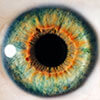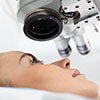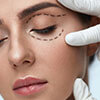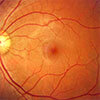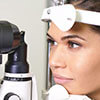Macular Degeneration
Fine Details Lost When Macula Breaks Down
Age-related macular degeneration (AMD), is the leading cause of irreversible poor vision after age 60. AMD is a deterioration or breakdown of the macula. The macula is a small but important area at the center of the retina that allows us to see fine details clearly and perform activities such as reading and driving.
Unfortunately, symptoms do not occur until vision loss has occurred. It is important to detect AMD before symptoms occur. Therefore, one should have an annual eye examination with dilation of the pupils up to the age of 60 and then as directed by your eye care provider.
Learn More About Macular Degeneration
Trouble
The visual symptoms of age-related macular degeneration (AMD) involve loss of central vision. While peripheral (side) vision is usually unaffected, one loses the sharp, straight-ahead vision necessary for driving, reading, recognizing faces, and looking at detail.
Although the specific cause is unknown, AMD seems to be part of aging. While age may be the most significant risk factor for developing clinical evidence of AMD, heredity, blue eyes, high blood pressure, cardiovascular disease and smoking also have been identified as risk factors which may increase the prevalence and/or severity of disease. AMD accounts for 90 percent of new legal blindness in the United States.
Atrophic (dry) form AMD
Nine out of ten people who have AMD have the dry form (called atrophic), which results in thinning of the macula.
Dry AMD takes many years to develop. Currently there is no treatment for this form of AMD, but nutritional supplements can slow its progression.
Exudative (wet) form AMD
The wet form of AMD (called exudative) is less common (occurring in one out of 10 people with AMD), but is more serious. In the wet form of AMD, abnormal blood vessels grow in a layer beneath the retina, leaking fluid and blood. This creates distortion or a large blind spot in the center of your vision.
Your retina specialist can direct the treatment that is best for your eyes and general health. Older and new treatments can be used to prevent further vision loss and often can lead to improvement.
Prevention can reduce vision loss
Since there is no cure for AMD, prevention is critical.
- Sunglasses – Some research shows that sunlight exposure may increase the risk of AMD, so routine use of sunglasses with UV filters is recommended outdoors.
- Antioxidants (vitamins C and E, and beta carotene) – Light may affect the eye by stimulating oxygen, leading to the production of highly reactive and damaging compounds called free radicals. Daily antioxidant supplements may work against this activated oxygen and help prevent vision loss in certain individuals who have moderately advanced AMD.
- Zinc – One of the most common minerals in our body, zinc is very concentrated in the eye, particularly in the retina and macula. Zinc is necessary for the action of over 100 enzymes, including chemical reactions in the retina. Studies show some older people have low levels of zinc in their blood. Because zinc is important for the health of the macula, supplements of zinc in the diet may slow down the process of macular degeneration.
Antioxidants and zinc lowered the risk of AMD progressing to advanced stages by 25-30 percent among people at high risk for late-stage macular degeneration (those with intermediate AMD in both eyes or advanced AMD in one eye) in the Age-Related Eye Disease Study (AREDS). However, the supplements did not appear to benefit people with minimal AMD, those with late-stage AMD, or those who have no evidence of macular degeneration.
It is very important to remember that vitamin supplements are not a cure for AMD, nor will they restore vision you may have already lost from the disease. However, specific amounts of certain supplements do play a key role in helping some people at high risk for advanced AMD to maintain their vision.
Promising AMD research is being done on many fronts. In the meantime, high-intensity reading lamps, magnifiers and other low-vision aids help people with AMD make the most of their remaining vision.
Frequently Asked Questions: Macular Degeneration Treatment
Q. Why do I need to have these treatments?
The mainstay of treatment for the wet, or exudative stage of macular degeneration involves the injection of anti-vascular endothelial growth factor (anti-VEGF) agents into the vitreous gel of the eye.
Q. How does the medicine work?
The abnormal blood vessels need a special protein to form. The medicine “blocks” the special protein from the blood vessel. If the blood vessel does not have this protein, the blood and fluid will dry up, the blood vessel will shrink and the vision may improve.
Q. What are the possible risks or side effects of the treatment?
There is a one in 1,000 to 5,000 chance of infection and a one in a million chance of loss of all vision in the eye and/or the eye itself. Although not proven, the medicine may affect your general health (see below).
Q. Why does the doctor ask me about my general health? Aren’t we talking about my eyes?
A microscopic amount of the medicine will leave the eye and enter the rest of your body through your bloodstream. The medicine affects all abnormal blood vessels, not just those in the eyes. If you have a history of heart disease, stroke or blood clot, the doctor may choose a different medicine that will be safer for you. It is very important to give the doctor a complete medical history, and to let the doctor know about any changes to your health or changes in the medicines you take.
Q. Will the treatment hurt?
The doctor and the assistants will give you eye drops and/or an anesthetic injection to numb your eye for the procedure. You will feel a slight pressure sensation as the doctor prepares your eye for the medicine, but most people do not feel the microinjection of medicine. Often people experience a dry and scratchy eye after having a treatment. We recommend using artificial teardrops every 2-3 hours after your treatment if you experience irritation for the first day or two.
Q. How many treatments will I need to have?
It is different for every person. It is very difficult to predict how many treatments a person will need. We will continue to give you the treatments until all the blood and fluid has dried up and the abnormal blood vessel has disappeared. If we stop the treatments too soon, the abnormal blood vessels are likely to return and the vision will decline. The goal is to limit the number and frequency of treatments and still protect your vision.
Q. How often do I need to have the treatments?
We will start by giving you the treatments every 4-6 weeks. Often, after several treatments we can space out the visits to every 6-8 weeks. If you come in after 8 weeks and your vision has declined or other evidence of disease activity is noted, we ask you to return to 4-6 week intervals. If you can go 8 weeks without losing any vision, then we may stretch the visits to 8-10 weeks. It is difficult to predict how each person will respond to the medicine.
Q. Why is it important for me to return when the doctor asks me to?
If you do not follow up for treatment in the given time frame, you may lose vision. Our goal is to keep you seeing well. If you do not return for treatment you may have irreversible vision loss or blindness. Eventually, if left untreated the abnormal blood vessel will form scar tissue. The scar tissue can cause distortion or blind spots in the vision. We cannot treat or remove the scar tissue; it will cause permanent damage.
Q. How do I know if the treatments are working?
The purpose of the treatment is to improve and/or maintain your vision. You should notice an improvement in your vision, or at least notice that it is not getting worse. The doctor (Optical Coherence Tomography) uses certain measurements to track your progress. We use a picture test called an OCT to measure the amount of blood and fluid in the macula. We use another picture test called an FA (fluorescein angiography) to look at the leaky blood vessel in the eye. The FA shows the doctor exactly where and how much the abnormal blood vessel is leaking and whether it is growing.
Q. What if I don’t want to have the treatments?
It is always your choice whether or not to get the recommended treatment. It is your right to refuse treatment. Please understand that often the damage to your vision is permanent, and we may not be able to regain vision that has been lost.
We strive to keep you seeing as well as possible, so that you can continue to live an active life and do the things that you enjoy.



